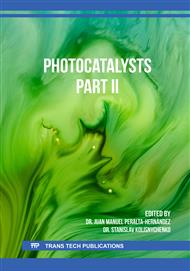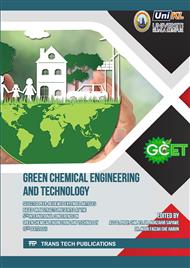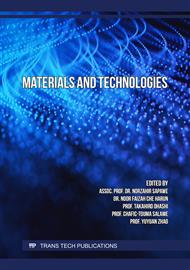[1]
Murgolo, S., Franz, S., Arab, H., Bestetti, M., Falletta, E., and Mascolo, G. (2019). Degradation of emerging organic pollutants in wastewater effluents by electrochemical photocatalysis on nanostructured TiO2 meshes. Water Research, 164, 114920.
DOI: 10.1016/j.watres.2019.114920
Google Scholar
[2]
Jain, S.N., Tamboli, S.R., Sutar, D.S., Jadhav, S.R., Marathe, J.V., Shaikh, A.A., and Prajapati, A.A. (2020). Batch and continuous studies for adsorption of anionic dye onto waste tea residue: kinetic, equilibrium, breakthrough and reusability studies. Journal of Cleaner Production, 252, 119778.
DOI: 10.1016/j.jclepro.2019.119778
Google Scholar
[3]
Titchou, F.E., Zazou, H., Afanga, H., El-Gaayda, J., Akbour, R.A., and Hamdani, M. (2021). Removal of persistent organic pollutants (POPs) from water and wastewater by adsorption and electrocoagulation process. Groundwater for Sustainable Development, 13, 100575.
DOI: 10.1016/j.gsd.2021.100575
Google Scholar
[4]
Darban, A.K., Shahedi, A., Taghipour, F., and Jamshidi-Zanjani, A. (2020). A review on industrial wastewater treatment via electrocoagulation processes. Current Opinion in Electrochemistry, 22, 154.
DOI: 10.1016/j.coelec.2020.05.009
Google Scholar
[5]
Trojanowicz, M. (2020). Removal of persistent organic pollutants (POPs) from waters and wastewaters by the use of ionizing radiation. Science of Total Environmental, 718, 134425.
DOI: 10.1016/j.scitotenv.2019.134425
Google Scholar
[6]
Atrous, M., Sellaoui, L., Bouzid, M., Lima, E.C., Thue, P.S., Bonilla-Petriciolet, A., and Ben-Lamine, A. (2019). Adsorption of dyes acid red 1 and acid green 25 on grafted clay: modeling and statistical physics interpretation. Journal of Molecular Liquids, 294, 111610.
DOI: 10.1016/j.molliq.2019.111610
Google Scholar
[7]
Zulfiqar, M., Samsudin, M.F.R., and Sufian, S. (2019). Modelling and optimization of photocatalytic degradation of phenol via TiO2 nanoparticles: An insight into response surface methodology and artificial neural network. Journal of Photochemistry and Photobiology A: Chemistry, 384, 112039.
DOI: 10.1016/j.jphotochem.2019.112039
Google Scholar
[8]
Hanafi, M.F., and Sapawe, N. (2020). A review on the water problem associate with organic pollutants derived from phenol, methyl orange, and remazol brilliant blue dyes. Materials Today: Proceedings, 31 (1), A141.
DOI: 10.1016/j.matpr.2021.01.258
Google Scholar
[9]
Hanafi, M.F., and Sapawe, N. (2020). A review on the current techniques and technologies of organic pollutants removal from water/wastewater. Materials Today: Proceedings, 31 (1), A158.
DOI: 10.1016/j.matpr.2021.01.265
Google Scholar
[10]
Sapawe, N., Jalil, A.A., Triwahyono, S., Sah, R.N.R.A., Jusoh, N.W.C., Hairom, N.H.H., and Efendi, J. (2013). Electrochemical strategy for grown ZnO nanoparticles deposited onto HY zeolite with enhanced photodecolorization of methylene blue: Effect of the formation of Si-O-Zn bonds. Applied Catalysis A: General, 456, 144.
DOI: 10.1016/j.apcata.2013.02.025
Google Scholar
[11]
Sapawe, N., Jalil, A.A., Triwahyono, S., Adam, S.H., Jaafar, N.F., and Satar, M.A.H. (2012). Isomorphous substitution of Zr in the framework of aluminosilicate HY by an electrochemical method: Evaluation by methylene blue decolorization. Applied Catalysis B: Environmental, 125, 311.
DOI: 10.1016/j.apcatb.2012.05.042
Google Scholar
[12]
Singh, P., and Borthakur, A. (2018). A review on biodegradation and photocatalytic degradation of organic pollutants: A bibliometric and comparative analysis. Journal of Cleaner Production, 196, 1669.
DOI: 10.1016/j.jclepro.2018.05.289
Google Scholar
[13]
Samsudin, M.F.R., Bacho, N., Sufian, S., and Ng, Y.H. (2019). Photocatalytic degradation of phenol wastewater over Z-scheme g-C3N4/CNT/BiVO4 heterostructure photocatalyst under solar light irradiation. Journal of Molecular Liquids, 277, 977.
DOI: 10.1016/j.molliq.2018.10.160
Google Scholar
[14]
Sun, M., Guo, P., Wang, M., and Ren, F. (2019). The effect of pH on the photocatalytic performance of BiVO4 for phenol mine sewage degradation under visible light. Optik, 179, 672.
DOI: 10.1016/j.ijleo.2018.10.211
Google Scholar
[15]
Keerthana, B.G.T., Solaiyammal, T., Muniyappan, S., and Murugakoothan, P. (2018). Hydrothermal synthesis and characterization of TiO2 nanostructures prepared using different solvents. Materials Letters, 220, 20.
DOI: 10.1016/j.matlet.2018.02.119
Google Scholar
[16]
Nyamukamba, N., Moloto, M.J., Mungondori, H. (2019). Visible light-active CdS/TiO2 hybrid nanoparticles immobilized on polyacrylonitrile membranes for the photodegradation of dyes in water. Journal of Nanotechnology, 2019, 1.
DOI: 10.1155/2019/5135618
Google Scholar
[17]
Zhang, H., Wang, X., Li, N., Xia, J., Meng, Q., Ding, J., and Lu, J. (2018). Synthesis and characterization of TiO2/graphene oxide nanocomposites for photoreduction of heavy metal ions in reverse osmosis concentrate. RSC Advances, 8, 34241.
DOI: 10.1039/c8ra06681g
Google Scholar




